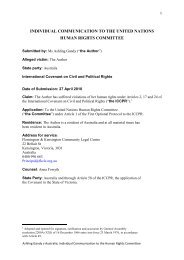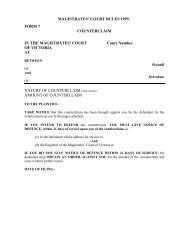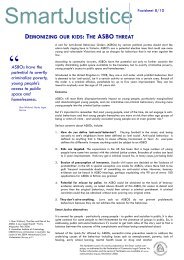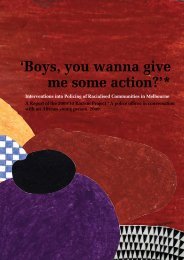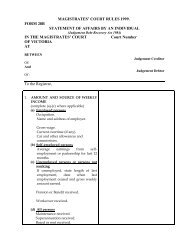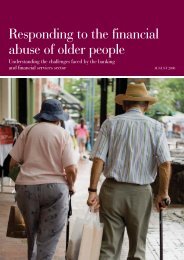49. Studies have confirmed <strong>the</strong> negative impact ethnic profil<strong>in</strong>g has on hit rates. A 1999 reviewof stop and frisk practices by <strong>the</strong> New York Police Department showed that although <strong>the</strong> Lat<strong>in</strong>opopulation of New York was about 22 percent, Lat<strong>in</strong>os made up about 33 percent of all of thosepolice stopped and frisked; <strong>the</strong> black population was approximately 24 percent, yet comprised about52 percent of those stopped and frisked. By contrast, <strong>the</strong> city’s white population (which constitutes40 percent of <strong>the</strong> city’s overall population) only made up about ten percent of all of those stoppedand frisked. The data showed a hit rate of 12.6 percent for whites, 11.5 percent for Lat<strong>in</strong>os and 10.5percent for blacks. <strong>Profil<strong>in</strong>g</strong> correlated directly to reduced efficiency of stops. Eliot Spitzer, AttorneyGeneral of <strong>the</strong> State of New York, The New York City Police Department’s ‘Stop and Frisk’ Practices:A Report to <strong>the</strong> People of <strong>the</strong> State of New York, New York, December 1, 1999.50. This figure was somewhat <strong>in</strong>flated by <strong>the</strong> <strong>in</strong>clusion of items such as penknives. E.J. van derTorre and H.B. Ferwerda, “Preventief fouilleren, Een analyse van het proces en de externe effecten<strong>in</strong> tien gemeenten” (Preventive search<strong>in</strong>g, an analysis of <strong>the</strong> process and <strong>the</strong> external effects <strong>in</strong>ten municipalities Politie & Wetenschap, 2005). Data are available from 187 preventive search operationsconducted from 2002 to 2004 <strong>in</strong> <strong>the</strong> cities of Amsterdam, Maastricht, Haarlemmermeer,Den Helder, Rotterdam, Heerlen, Utrecht, and Tilburg. Data <strong>in</strong>clude <strong>in</strong>formation on <strong>the</strong> cost of<strong>the</strong> policy <strong>in</strong> terms of man-hours, and on police conduct. Dur<strong>in</strong>g <strong>the</strong>se operations, 79,499 personswere searched and 2,010 weapons (as def<strong>in</strong>ed by <strong>the</strong> Weapons and Ammunition Act) were found:68 percent stabb<strong>in</strong>g weapons; 16.8 percent were strik<strong>in</strong>g weapons and 2.6 percent were firearms(52 units); 12.6 percent fall <strong>in</strong>to a category of “o<strong>the</strong>r.” The study <strong>in</strong>volv<strong>in</strong>g all 10 cities suggests thatcreative account<strong>in</strong>g took place on a modest scale to <strong>in</strong>crease <strong>the</strong> seem<strong>in</strong>g effectiveness of <strong>the</strong> results.Thus hobby knives (fish<strong>in</strong>g knives), for example, were also counted.51. Ibid. Dur<strong>in</strong>g 54 preventive search operations <strong>in</strong> Amsterdam from November 2002 to March2004, police searched 32,332 <strong>in</strong>dividuals and detected 702 weapons, only 15 of which were firearms.The operation cost 11,687 officer hours. Results <strong>in</strong> Rotterdam were similar: <strong>in</strong> 50 operations total<strong>in</strong>g9,124 officer hours, 18,687 searches were carried out that detected 578 weapons, 23 of which werefirearms.52. Joel Miller, Nick Bland and Paul Qu<strong>in</strong>ton, “The Impact of Stops and Searches on Crime and<strong>the</strong> Community,” Police Research Series Paper 127, London: Home Office, 2000; Ronald Weitzer andSteven A. Tuch, “Determ<strong>in</strong>ants of Public Satisfaction with <strong>the</strong> Police,” <strong>in</strong> Police Quarterly No. 8(3)2005: 279–297; Joel Miller, Robert C. Davis, Nicole J. Henderson, John Markovic and ChristopherW. Ortiz, “Public Op<strong>in</strong>ions of <strong>the</strong> Police: The Influence of Friends, Family, and Media,” NationalInstitute of Justice Technical Report (2001-IJ-CX-0038); Dennis P. Rosenbaum, Amie M. Schuck,Sandra K. Costello, Darnell F. Hawk<strong>in</strong>s, and Marianne K. R<strong>in</strong>g, “Attitudes toward <strong>the</strong> police: Theeffects of direct and vicarious experience,” Police Quarterly No. 8(3), 2005, 343–365.53. John D. McCluskey, Stephen D. Mastrofski, and Roger B. Parks, “To acquiesce or rebel:Predict<strong>in</strong>g citizen compliance with police requests,” Police Quarterly No. 2, 389–416.54. Rod Morgan and Tim Newburn, The Future of Polic<strong>in</strong>g, Oxford: Clarendon Press/OxfordUniversity Press, 1997.55. Ibid.56. C. Stone and H. Ward, “Democratic Polic<strong>in</strong>g; A Framework for Action,” Polic<strong>in</strong>g and <strong>Society</strong>,Vol. 10, No. 1, 11–45.210 NOTES
57. R. Davis and P. Mateu-Gelabert, Respectful and Effective Polic<strong>in</strong>g: Two Examples <strong>in</strong> <strong>the</strong> SouthBronx, New York: Vera Institute, March 1999.58. <strong>Ethnic</strong> <strong>Profil<strong>in</strong>g</strong>, CRF–CDF.Op<strong>in</strong>ion4-2006, at 6.59. Allgeme<strong>in</strong>es Gleichbehandlungsgesetz {General Equal Treatment Act) of 14 August 2006.cited <strong>in</strong><strong>Ethnic</strong> <strong>Profil<strong>in</strong>g</strong>, CRF–CDF.Op<strong>in</strong>ion4-2006, at 33.60. Article 8 Racial Equality directive; ECRI General Policy Recommendation No. 7 on Nationallegislation to combat racism and racial discrim<strong>in</strong>ation at 11 and Explanatory report at 29.61. In “test<strong>in</strong>g” methods, practices reported as discrim<strong>in</strong>atory are put to <strong>the</strong> test through <strong>the</strong>deliberate effort by m<strong>in</strong>ority applicants to access <strong>the</strong> good or service <strong>in</strong> question and establishwhe<strong>the</strong>r <strong>the</strong>y are treated equally with majority applicants—<strong>in</strong> apply<strong>in</strong>g for employment or hous<strong>in</strong>gfor example—and document<strong>in</strong>g <strong>the</strong> results for presentation as evidence <strong>in</strong> litigation. The PragueAirport case discussed <strong>in</strong> Annex A to this Handbook used test<strong>in</strong>g to establish that UK border agentswere discrim<strong>in</strong>at<strong>in</strong>g aga<strong>in</strong>st Czech citizens of Roma orig<strong>in</strong> <strong>in</strong> immigration decisions.62. Equality Act 2010. Available at: http://www.legislation.gov.uk/ukpga/2010/15/pdfs/ukpga_20100015_en.pdf. The Equalities Act 2010 is law <strong>in</strong> England, Scotland, and Wales. Nor<strong>the</strong>rn Irelandis covered by separate legislation outl<strong>in</strong>ed below.63. Paragraph 17(4)(a) of Schedule 3 to <strong>the</strong> Equality Act 2010.64. S. 75(1) and s. 75(2) Statutory duty on public authorities.65. Article 41.66. Article 20A(3).67. Article 20C(1).68. Commission Nationale pour la Déontologie de la Sécurité (CNDS), Sais<strong>in</strong>e no. 2009-77.Translation by <strong>the</strong> <strong>Open</strong> <strong>Society</strong> Justice Initiative.69. Preamble, paragraph J.70. Justice Initiative <strong>in</strong>terview; name withheld on request.71. Paragraph 5(1), “Guidel<strong>in</strong>es Regulation” (BGBI 1993/266 idGF).72. M<strong>in</strong>istry of Justice, Statistics on Race and <strong>the</strong> Crim<strong>in</strong>al Justice System—2006/7, London: M<strong>in</strong>istryof Justice, 2008, at 24 and 32.73. Council of Europe, Code of Police Ethics, adopted by <strong>the</strong> Council of M<strong>in</strong>isters on 19 September2001, http://cm.coe.<strong>in</strong>t/ta/rec/2001/2001r10.htm, Article 47.74. Gus<strong>in</strong>ski v. Russia, App. No. 70276/01, Eur. Ct. Hum. Rts., Judgment of May 29, 2004, para.53. The United States Supreme Court established <strong>in</strong> Terry v. Ohio that reasonable suspicion is morethan an “<strong>in</strong>choate and unparticularized suspicion or ‘hunch’ but must be based on specific andarticulable facts taken toge<strong>the</strong>r with rational <strong>in</strong>ferences from those facts.” Those factors must relateto a person’s behavior. The US Supreme Court has found it unconstitutional to stop and frisk aperson simply because <strong>the</strong>y are <strong>in</strong> a high-crime area (although “high-crime area” may be cited as acontribut<strong>in</strong>g factor).75. <strong>European</strong> Commission, EU Network of Independent experts <strong>in</strong> fundamental rights, <strong>Ethnic</strong><strong>Profil<strong>in</strong>g</strong>, CFR–CDF.Op<strong>in</strong>ion4, 2006.REDUCING ETHNIC PROFILING IN THE EUROPEAN UNION 211
- Page 1:
OPEN SOCIETY JUSTICE INITIATIVERedu
- Page 6 and 7:
described in this report. The case
- Page 9 and 10:
List of Case StudiesThe case studie
- Page 11 and 12:
UNITED KINGDOMAUSTRIA/BELGIUM/BULGA
- Page 13:
UNITED KINGDOMUNITED KINGDOMNETHERL
- Page 16 and 17:
The United Nations, the Council of
- Page 19 and 20:
I. Ethnic Profiling DefinedA Compre
- Page 21 and 22:
The use by the police, with no obje
- Page 23 and 24:
explicitly on their membership in a
- Page 25 and 26:
of the persons subjected thereto sh
- Page 27 and 28:
The impact of ethnic profiling on c
- Page 29 and 30:
of the ethnic minorities disproport
- Page 31 and 32:
II. A Holistic Approachto Reducing
- Page 33 and 34:
Law enforcement agencies are accoun
- Page 35 and 36:
III. Legal Standards andInstitution
- Page 37 and 38:
Criminal and Administrative Legal R
- Page 39 and 40:
ImmigrationThe Equality Act covers
- Page 41 and 42:
FRANCEObligation of Non-Discriminat
- Page 43 and 44:
General principles of good practice
- Page 45 and 46:
UNITED KINGDOMPolice and Criminal E
- Page 47 and 48:
has lasted for an hour, the examini
- Page 49 and 50:
In order to conduct a check using a
- Page 51 and 52:
the person could pose a threat to p
- Page 53 and 54:
Improving law enforcement relations
- Page 55:
IRELANDPolicing Plan 2008The Garda
- Page 58 and 59:
officer misconduct more than patter
- Page 60 and 61:
complaints commissions that include
- Page 62 and 63:
Civilian oversight can and should d
- Page 64 and 65:
In Ireland and Northern Ireland, po
- Page 66 and 67:
These case studies also demonstrate
- Page 68 and 69:
NETHERLANDSNational OmbudsmanThe Du
- Page 70 and 71:
UNITED KINGDOM / NORTHERN IRELANDNo
- Page 72 and 73:
DENMARKThe Danish Institute of Huma
- Page 74 and 75:
• the impact of race• the use o
- Page 76 and 77:
UNITED KINGDOMThe Communities and L
- Page 78 and 79:
used, such as those described below
- Page 80 and 81:
passengers at borders, although the
- Page 82 and 83:
UNITED KINGDOMMerseyside Police Rev
- Page 84 and 85:
Reducing Ethnic Profiling and Impro
- Page 86 and 87:
As the above examples indicate, dat
- Page 88 and 89:
Research Approaches and Methodologi
- Page 90 and 91:
Observational studies were pioneere
- Page 92 and 93:
The study revealed that in addition
- Page 94 and 95:
esponses, and in some cases, broad
- Page 96 and 97:
UNITED STATESAttitudinal Survey of
- Page 98 and 99:
UNITED KINGDOMThe Views of the Publ
- Page 100 and 101:
NORTHERN IRELANDBeyond the Margins:
- Page 102 and 103:
DENMARKMedia Reporting of Police St
- Page 105 and 106:
VI. Strategies for Reducing EthnicD
- Page 107 and 108:
people were stopped and valuable po
- Page 109 and 110:
only do so if the measure is determ
- Page 111 and 112:
Supervision and Oversight of Front-
- Page 113 and 114:
This is not to say that stop forms
- Page 115 and 116:
• Recording of self-defined ethni
- Page 117 and 118:
UNITED KINGDOM“Know Your Rights
- Page 119 and 120:
Prior to the ride-alongs, many Hung
- Page 121 and 122:
General principles of good practice
- Page 123 and 124:
UNITED KINGDOMMonitoring the Qualit
- Page 125:
GREECEProhibition of Racist Languag
- Page 128 and 129:
This handbook recommends that law e
- Page 130 and 131:
Where possible, training should inc
- Page 132 and 133:
SWEDENPolice and Youth Sharing Expe
- Page 134 and 135:
Training in the Counter-radicalizat
- Page 137 and 138:
VIII. Changing Institutional Cultur
- Page 139 and 140:
and Wales have used the package. Mo
- Page 141 and 142:
NORTHERN IRELANDCreating a More Bal
- Page 143 and 144:
Moroccan man. Another minority offi
- Page 145 and 146:
General principles of good practice
- Page 147:
General principles of good practice
- Page 150 and 151:
other characteristics or values. Co
- Page 152 and 153:
Take steps to ensure that all parts
- Page 154 and 155:
Law enforcement agencies must be se
- Page 156 and 157:
A large number of Polish migrants h
- Page 158 and 159:
variety of individuals with “life
- Page 160 and 161:
UNITED KINGDOMCommunity Stop and Se
- Page 162 and 163: their needs, and problems, and hear
- Page 164 and 165: to travel as far as Liverpool to ac
- Page 166 and 167: The strategy includes multiple init
- Page 168 and 169: The website provides an interactive
- Page 170 and 171: General principles of good practice
- Page 173 and 174: Appendix A:Sample Stop Forms171
- Page 175 and 176: REDUCING ETHNIC PROFILING IN THE EU
- Page 177 and 178: REDUCING ETHNIC PROFILING IN THE EU
- Page 179 and 180: REDUCING ETHNIC PROFILING IN THE EU
- Page 181 and 182: REDUCING ETHNIC PROFILING IN THE EU
- Page 183 and 184: REDUCING ETHNIC PROFILING IN THE EU
- Page 185 and 186: Fuenlabrada, Spain Stop FormREDUCIN
- Page 187 and 188: REDUCING ETHNIC PROFILING IN THE EU
- Page 189 and 190: REDUCING ETHNIC PROFILING IN THE EU
- Page 191: West Yorkshire Police Stop ReceiptR
- Page 194 and 195: Covenant rights that are especially
- Page 196 and 197: • Necessity: The use of ethnic pr
- Page 198 and 199: The clear risk of arbitrariness in
- Page 200 and 201: The Committee considers that identi
- Page 202 and 203: adopted on June 29, 2007, CRI/Counc
- Page 204 and 205: European Union Fundamental Rights A
- Page 207 and 208: Notes1. Rebekah Delsol, Open Societ
- Page 209 and 210: 13. A report of MI5’s behavioral
- Page 211: 38. From the email text sent by Tem
- Page 215 and 216: 88. Gillan and Quinton v. United Ki
- Page 217 and 218: Ireland). Of the total number of co
- Page 219 and 220: 139. For example, European Commissi
- Page 221 and 222: 165. Open Society Justice Initiativ
- Page 223 and 224: 197. These can be found at: http://
- Page 225 and 226: 230. More information can be found
- Page 227 and 228: 266. To undertake this kind of anal
- Page 229 and 230: 279. In Rosalind Williams, Spanish
- Page 232: Ethnic profiling by police in Europ



